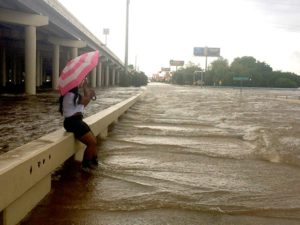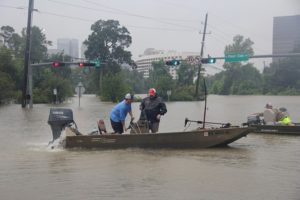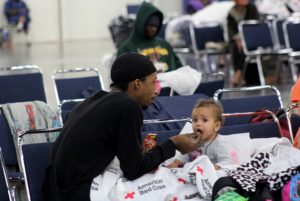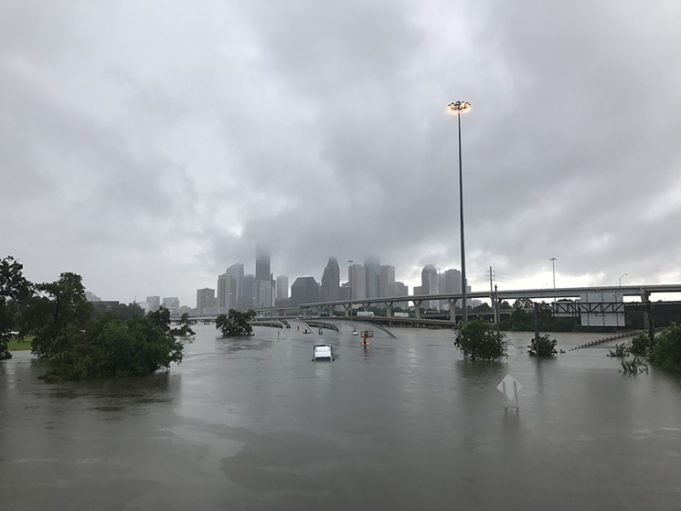It was 2:30 a.m., but Samwa and Richard David couldn’t sleep, not with the water pouring into their house. The couple sat at the dining-room table, their feet propped up on chairs to avoid the growing pool of water in their one-story home in the southwest Houston neighborhood of Westbury. They sat for hours, tuned into the live coverage of Tropical Storm Harvey’s ongoing destruction across Houston, until the TV stopped working. Before the floodwaters had risen over their knees, the 66- and 81-year-old had tried to save what they could.
“We were sure it was gonna happen,” Samwa said of the house flooding, “because we were flooded in 2015. But this time it was much worse. We tried to save our stuff, because we just cleaned the water up two years ago, but we couldn’t. The water was too high.”
It was the story that played out across the Houston area as thousands of people awaited rescue from their own homes. If the empty shelves at the grocery stores and the lines at the gas stations were any indication, Houstonians had been prepared for this outcome, a card in a deck of possible worst-case scenarios. They had seen this before: the Tax Day floods of 2016, Memorial Day floods of 2015, Ike in ’08, Allison in ’01.
Still, even as the rain began falling in Houston well before Hurricane Harvey slammed into the mid-Texas coast late Friday night — boasting winds upwards of 130 miles an hour — a long, deceiving lull between rainstorms Saturday afternoon had many thinking perhaps Harvey wasn’t all it was hyped up to be.
Then they woke up.
The scenes Houstonians would find early on the morning of Sunday, Aug. 27, were, to an extent, familiar: abandoned cars submerged on the highways, people being rescued on boats and carried by firefighters over brown, murky water, the bayous so swelled they appeared, in some places, more like lakes.
The magnitude, however, was something even the most veteran Houstonians said they had never seen before. Regrettably.
Before daylight even came, it was clear that Tropical Storm Harvey was quickly becoming the storm of the decade and perhaps much more than that. Eric Berger, Houston’s chief “no-hype” meteorologist at Space City Weather, said in a post on Monday that Harvey is “almost certainly” the biggest flood-producing storm in U.S. history, citing a model by state climatologist John Nielsen-Gammon.
The vast majority of bayous had jumped their banks, spilling into roadways and homes and buildings. Some water gauges in Houston were recording rainfall rates exceeding 500-year flood levels as of Sunday morning.
And when Houstonians turned on their TVs to assess the wreckage, they found on the local news stations what seemed to be footage from a sci-fi movie, the kinds about apocalypses where strangers must band together to conquer disaster. People were evacuating from areas that had never had a flooding problem before, and roughly 100,000 people lost power by Monday. In less than 24 hours after Saturday night’s storm began, more than 56,000 people had called 911 and more than 6,000 requested high-water rescues. As of Tuesday, more than 10,000 people had been taken to the George R. Brown Convention Center, plus thousands more at various shelters across Harris County. City officials have confirmed at least four deaths, including a veteran Houston police officer, Sgt. Steve Perez, who drowned in high water at I-45 and Hardy Toll Road on his way to work Sunday morning. Unconfirmed reports have tallied an additional six fatalities.
By Sunday evening, Harvey had exceeded the rainfall and flooding caused by 2001’s Tropical Storm Allison in half the time. By the end of the day Monday, Harvey had unleashed more than 15 trillion gallons of water on the greater Houston region (compared to 6.5 trillion during Hurricane Katrina) and more than 30 to 35 inches of rain — more than half the amount Houston generally receives all year, in less than a week. President Donald Trump has since issued a federal disaster declaration and recently surveyed the damage.
The area could use all the federal help it can get. As Harris County and the City of Houston have continued to scramble to respond to the overwhelming stream of 911 calls, tired and anxious residents have begun asking the hard questions before the rain even stopped falling: Could their government have done something more to prevent not the rainfall but the catastrophe? Should they have evacuated? And with the worst flood in Houston history now on the books, just how long is the road to recovery?
These, however, were largely only questions that those who had found a dry place could begin considering. For people like Samwa and Richard David, the most pressing question was how much longer would they have to sit at the dining-room table, waiting for help? They had called 911 a d the Coast Guard, but after nearly 22 hours, it became clear that no one was coming.
“Our kids were trying on Sunday to get us help, to get us out of there,” Samwa said. “But a lot of people needed help all around Houston. So around 12:30 or 12:45 a.m. Monday, we gave up.”

It wasn’t long before Tully Corcoran’s mattress had become a small island inside his one-story home in his Westbury neighborhood.
Before Category 4 Hurricane Harvey hit Texas, Corcoran and his wife Abby, like most Houstonians, had made all the right preparations, even purchasing flood barriers to place in front of their doors to keep the water out.
Their home had flooded during the 2015 Memorial Day flood. But with all the improvements the city had made since then — drainage upgrades at the Willow Waterhole; diversion of runoff from other neighborhoods — the Corcorans thought their house would be safe going forward. The Memorial Day event was, after all, a 100-year flood.
“We thought, ‘We’re never gonna see anything like this again,’” Corcoran said.
Given Saturday’s daytime rain lull, they remained optimistic. A nearby neighbor, Kevin Hester, said he and some friends had gone out to watch the Mayweather-McGregor fight that night, thinking that with five days of Harvey up ahead, the worst of the storm likely wouldn’t happen within the first few hours.
Then around 9 p.m., it did.
The rain fell progressively harder and faster, prompting Mayor Sylvester Turner and Police Chief Art Acevedo to hold an emergency press conference around 10. They told Houstonians to get off the roads immediately. One woman had already drowned when her car was flooded at South Gessner and Warrenton. Hester, trying to get home quick, dropped off his friends in the Heights, maneuvering his way around floodwaters accumulating at astounding rates. When he got back to Westbury — after having to park his car in Meyerland to walk the last three miles — water was already inside his house. The sandbags made no difference.
Inside the Corcorans’ home, the flood barriers they bought lasted about 30 minutes. Corcoran poured himself a glass of whiskey to help himself sleep. All he could think about was the two inches of water on the floor beneath him.
According to the National Weather Service, more than a foot and a half of rain drenched much of the Houston area from 7 p.m. to 7 a.m., with some places, such as South Houston, receiving as much as 10 inches in just three hours, exceeding the 500-year-flood rainfall rate.
Residents at two apartment complexes in Greenspoint, where more than a foot of rain fell overnight, were the first to evacuate. More than 200 people from the Arbor Court Apartments, which were deluged during the Tax Day Floods, and a complex at 400 Greens Rd. were taken to the M.O. Campbell center overnight on Metro buses, with many of them experiencing their second major flood evacuation in as many years.
By 4:45 a.m., the City of Houston had issued an alert on social media that the 911 system was at capacity and asked residents not to call 911 unless they were in life-threatening situations. First responders had received more than 2,000 calls for high-water rescues throughout the night and would soon be backlogged with thousands more.
When the sun came up, the Corcorans awoke to find the two inches had grown to two feet, confining them to their island bed for most of the day.
Corcoran and his wife started stocking the attic with food, water, candles, and even a smaller mattress. Early Sunday, the National Weather Service had advised people not to go up into their attics to escape floodwaters but instead to go to their roofs, where rescuers could see them. But Corcoran said his friend who lives in Meyerland had called 911 and had gone to the roof to be rescued, but no one ever came. The Corcorans decided against the roof.
They put an ax in the attic, in case they needed to break through.

As chaos ensued Sunday morning, reporters first posed the question that was on many Houstonians’ minds to Mayor Turner at his first press conference of the day: Did he regret not issuing an evacuation order?
Tensions initially arose after Gov. Greg Abbott advised Houstonians on Friday afternoon that they should “strongly consider” evacuating Houston.
“There is the possibility that people may have to go a long time without access to basic necessities, without access to water, food, power,” Abbott said. “If you have the ability to evacuate and go somewhere else for a little while, it would be good.”
It was confusing: Houston and Harris County officials had issued no such directive, and in fact, Turner expressly advised against it, saying mass evacuations in the city of Houston had proven dangerous in the past and were simply not necessary, given that Houston was not in the hurricane’s direct path. Harris County Judge Ed Emmett echoed the mayor’s comments. Turner recalled the total disaster that took place during the Hurricane Rita evacuation in 2005 when, as millions of people fled the city at once, they were trapped in immense gridlock on the freeways. More than 100 people died on the road from heat-related illness or, in the case of 24 nursing home evacuees, a bus fire. The hurricane never even hit the city.
For Turner, the math was simple: Risk a repeat of the fatal disaster or keep as many people as possible off the roads, where the most fatalities happen, and evacuate people as needed?
The latter option meant it was all hands on deck for local first responders, who have saved thousands of people; in fact, Harris County Sheriff’s Office spokesman Jason Spencer said it may be safe to assume tens of thousands of people have been rescued by all agencies involved, including the Texas National Guard, the Texas Task Force, and the U.S. Coast Guard, which itself rescued 3,600 by air and boat.
Yet even with 35 rescue boats, 93 high-water vehicles, and 22 aircraft at their disposal, responding to the ever-growing number of 911 calls was overwhelming. The Harris County Office of Homeland Security and Emergency Management put out a call to residents, asking anyone with a boat to volunteer to help with rescues.
Kevin Hester didn’t need to think twice.
With his house flooded with about two feet of water, Hester and his brother gathered what they needed and began wading through the floodwaters around noon, headed to their neighbor’s house, where nearly a dozen others were already gathered. Debra and Marc Tice’s home had a second floor, a rare feature in Westbury, Hester said. They also had an 18-foot canoe.
Hester and Debra and Marc’s son, Simon Tice, started looking for people. (Bravery apparently does not run short in Tice’s family: Debra and Marc’s other son, Austin Tice, went to Syria to report on the war as a journalist but was kidnapped and has been missing since 2012. His parents say they are certain he’s still alive.)
“We left our house around noon,” Hester said. “We never stopped after that.”
First Tice and Hester picked up an older couple with medical issues and a young child and pushed the canoe about a mile on Bellfort to Fondren, to drier ground. They were rowing back down Bellfort when people yelled at them from an apartment complex that an elderly woman was trapped underneath a gas station awning up the road, surrounded by water. She had been trying to reach a family member on foot when the floodwaters became too menacing.
After bringing her to safety, they would rescue two more couples, a baby, and three children before deciding to head back to the Tices’ for a quick breather. Often, after loading families into the canoe, Tice and Hester would get back in the water themselves.
“Out on main roads, it was pretty dicey, because you have a current going down the roads from the bayous,” he said. “On Bellfort, there was a lot of debris. Stuff would just hit your legs. But you can’t think about snakes or anything like that. There’s not enough snakes in the world to be in as much water as we had.”
Around this time — Sunday afternoon — the flash flood warnings for the evening ahead continued and so did the evacuation orders. Two hospitals, Ben Taub and Memorial Hermann in Sugar Land, would soon be evacuated because of flooding issues. In Fort Bend County, those in low-lying areas near the Brazos and San Bernard rivers, which were rising at record levels, faced mandatory evacuations. And those near the Addicks and Barker dams in Harris County would be asked to evacuate voluntarily. On Monday at 1 a.m., the U.S. Army Corps of Engineers began slowly releasing water from the reservoirs to relieve the pressure on the dams, putting nearby residents at even more serious risk of flooding but minimizing the risk that water would break through and rush down Buffalo Bayou.
Initially the measure did not appear to be having the desired effect; The reservoirs’ water levels continued to rise despite the release. By Tuesday, conditions didn’t seem to have improved, waters were still rising, and Addicks slopped over its reservoir banks for the first time in history.
Edmond Russo of the Corps of Engineers noted the dams were built in the 1940s to hold water from a 1,000-year flood. They were over capacity.
It was getting dark. By 6 p.m., thousands of people were still needing to be rescued, and soon the rain picked up.
Hester started using the neighborhood app Nextdoor to find out who was still in danger once the sun set, but he had come up empty on one long trip. At 1 a.m., his friend Lorraine brought to his attention that an elderly couple just down the street from them had been trapped in their living room for hours, awaiting help that never came. The two friends started canoeing — unbeknownst to Samwa and Richard David, still unable to sleep in their flooded home for the second night in a row.
Around 2:15 in the morning, 24 hours since the water first came in, the Davids heard a knock at the door.

It may be weeks, maybe months, before the aftermath of Tropical Storm Harvey can be reasonably understood — perhaps best evidenced by a message on Twitter from the National Weather Service sent out Sunday evening: “This event is unprecedented & all impacts are unknown & beyond anything experienced.” Saying it was at least safe to call it a 500-year flood, Scott Overpeck, a meteorologist at the Houston/Galveston NWS, said Houstonians shouldn’t think it can happen only once every 500 years.
“A 500-year flood refers to a 0.2 percent chance of it happening in any given year,” he said. “When you think about it like that, that’s how rare this type of event is. To describe it, the terms ‘extremely rare,’ ‘catastrophic’ — whatever extreme adjective you could think of is really appropriate. The chances of this happening are very, very, very small. But that’s not to say it can’t happen again in the near future. I don’t want anybody to think this can’t happen again.”
For now, however, thinking about even the next minor rainstorm could be dizzying for much of Houston, which is desperate for sunlight and unsettlingly accustomed to the sound of rain hitting the windows as perpetual background noise. Thousands of people across Houston have no windows to call their own, sleeping on cots at the city’s shelters in large gymnasiums and multi-service centers. Mayor Turner visited the George R. Brown Convention Center Monday, offering the best sense of resiliency he could muster to people who had told him they had lost everything.
“But for the grace of God, any one of us could be here,” Turner said over the cries of tired infants and toddlers in the background. “This is one of those times that Houston comes together, bands together, supports one another, and helps people transition back to a normal routine.”
Which will be the most difficult part.
By next week, the hundreds of displaced children will need to go back to school. How will they all get to the right ones? Soon their parents will need to go back to work. Who will take them? Soon after that, they will need permanency, a real home again. How?
Many have likely lost their homes for good, while many others who do not own their homes will need landlords to assist in scheduling repairs to make their apartments or homes habitable again. Those who cannot return will get in line for temporary housing.
Following the Tax Day floods in April 2016, the city worked with the Houston Housing Authority, the Houston Apartment Association, and landlords across town to help find displaced Greenspoint residents new, temporary apartments — but the number of evacuees at that time was just a tiny fraction of the volume of people Harvey has displaced. Turner has said plans are in the works.
Tully Corcoran said he has thought hard about whether the Turner administration could have done more to protect them, about whether he should be mad. It’s the same question everyone in nearby Meyerland asks during every major rainstorm, after nearly begging for comprehensive drainage improvements beyond Project Brays, the Brays Bayou expansion. It’s why those in Greenspoint questioned whether the city had simply neglected them while sprawling apartment complexes were built just behind Greens Bayou. And it’s why the group Residents Against Flooding sued the city last year, saying it had failed to follow development rules to prevent flooding while building the massive concrete jungle that is Memorial City. (The lawsuit was dismissed in June but is on appeal.)
But this time, Corcoran said, it was different. He was mad only at the sky.
Early Monday morning, Corcoran and his wife would leave their island bed. They would get in their flooded-out Honda CR-V with wet seats and water in the cupholders and would head north going the wrong way on I-45 to avoid floods and get to safety in Huntsville. They started talking about what color they would want to paint the walls next and what will they do about the ruined cars? Because after hours trapped inside on Sunday, they realized there was nothing they could have done to save the house, that no one could have, and it was no use thinking about what might have been.
“Yesterday afternoon, I finally just gave up,” Corcoran said. “I stood there in the water, looking out the window, drinking whiskey, waiting for the storm to be over.”
This story orginally appeared in the Houston Press.












